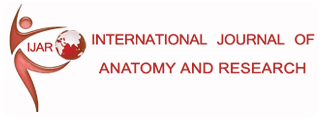IJAR.2025.104
Type of Article: Original Research
Volume 13; Issue 1 (March 2025)
Page No.: 9157-9161
DOI: https://dx.doi.org/10.16965/ijar.2025.104
Radiological Evaluation of Length of the Styloid Process of Temporal Bone in Multi-detector CT images- A Retrospective Study
Sarala HS *1, Pravin GU 2, Jyothilakshmi GL3, Sindhu N 4*.
1 Professor, Department of Anatomy,Rajarajeswari Medical college and Hospital. Bengaluru, Karnataka. India. ORCiD: https://orcid.org/0000-0001-8704-9488
2 Professor, Department of Radiodiagnosis, Principal,Sri Chamundeshwari Medical college, Hospital and Research Institute, Chennapatna, Karnataka, India. ORCiD: https://orcid.org/0000-0001-7703-1962
3 Assistant Professor, Department of Anatomy, Shri Atal Bihari Vajpayee Medical College and Hospital, Shivajinagar, Bengaluru, Karnataka, India. ORCiD: https://orcid.org/0000-0001-5270-7508
*4 Professor, Department of Radiodiagnosis, Rajarajeswari Medical college and Hospital, Bengaluru, Karnataka, India. ORCiD: https://orcid.org/0000-0002-4486-4877
Corresponding author: Dr.Sindhu N, Professor, Department of Radiodiagnosis. Rajarajeswari medical college and hospital, Bengaluru, Karnataka, India. E-Mail: dr.sindhu02@gmail.com
ABSTRACT
Background: Styloid process (SP) is a cylindrical piece of bony projection from petrous part of temporal bone. SP is clinically important anatomical entity due to pathologies caused by changes in its length. The average length is 25mm- 30mm, measurements of 30mm & greater indicate elongation of SP. It is necessary to have knowledge of normal anatomy of the structures involved & standardized morphometric measurements to evaluate the pathological changes related to the disease.
Objectives: To evaluate the Length of the styloid process of temporal bone using 3D reconstructed images of MDCT (Multi-detector Computed Tomography).
To investigate the possibility of occurrence of Eagle’s syndrome in asymptomatic individuals.
Materials and methods: This study was conducted on CT(Computed Tomography) images of 400 patients who underwent para nasal and Head and neck MDCT between March 2024 and June2024. The images were assessed retrospectively. The length of the styloid process from its attachment on the temporal bone to the tip was measured in 3D reconstructed images using Volume rendering technique(VRT) and an inbuilt dedicated workstation. The measurements were undertaken in centimeters, obtained data was tabulated and analysed statistically.
Results: The mean length of Styloid process among 400 CT images evaluated is 3.1± 0.5cm on the right side and 3.3± 0.61cm on the left side. Mean length of SP in males is 3.13±0.57cm on right side and 3.12±0.56 on the left side, in females it is 3.07±0.62cm and 3.08± 0.68cm on the right and left side respectively. Elongated Styloid process(≥3cm) is observed in 60.5% and 59% on the right and left side respectively. Elongated SP is noted in 23.75% of males and 21.75% of females.
Conclusion: The average length of the styloid process is consistent with the results of other studies reported in the literature. This data guides the clinicians in diagnosing Eagle’s syndrome in asymptomatic individuals. It can also help the clinicians to avoid misinterpretation of symptoms like tonsillar pain, pain of dental or muscular origin.
KEY WORDS: Styloid process, Eagle’s syndrome, elongated styloid process, stylohyoid ligament.
REFERENCES
[1]. Grays Standring S: Skull and Mandible. In Gray’s Anatomy. The Anatomical basis of clinical practice.39th edition. Elsevier, Edinburg; 2005:470.
[2]. Shreyas Predeepkumar Shah, NB Praveen, Vaseemuddin Syed, AR Subhashini.Elongated Styloid Process: A Retrospective Panoramic Radiographic Study. World Journal of Dentistry,2012;3(4):316-319.
https://doi.org/10.5005/jp-journals-10015-1181
[3]. Gulam Anwer Khan, Sushma Khatiwada,Shuvechha Shakya, Deepak Adhikari, Ajeevan Gautam. 3D-MDCT study of Styloid process of temporal bone among patients attending Chitwan medical college teaching hospital..Journal of Chitwan Medical College 2021;11(38):52-55
https://doi.org/10.54530/jcmc.577
[4]. N.Cullu, M.Deveer, M.Sahan, H. Tetiker, M. Yilmaz.Radiological evaluation of the styloid process length in the normal population. Folia Morphol.2013; 72(4):318-321.
https://doi.org/10.5603/FM.2013.0053
PMid:24402753
[5]. A.H.Baykan,Z.Doğan,G.Özcan.Acomputed tomography-base morphometric study of the styloid process.Folia Morphol. 2013; 79(1):120-126.
[6]. Beder E,Ozgursoy OB,Karatayli OS, Anadolu Y.Three-dimensional computed tomography and surgical treatment for Eagle’s syndrome. Ear Nose Throat J.2006; 85: 443-445.
https://doi.org/10.1177/014556130608500715
PMid:16909816
[7]. Chiang KH, Chang PY, Chou AS, Yen PS, Ling CM. Eagle’s syndrome with 3-D reconstructed CT: two cases report. Chin J Radiol.2004;29: 353-357.
[8]. Chuang WC, Short JH, McKinney AM, Anker L, Knoll B, McKinney ZJ. Reversible left hemispheric ischemia secondary to carotid compression in Eagle syndrome: Surgical and CT angiographic correlation.Am J Neuroradiol,2007; 28: 143-145.
[9]. Eagle WW. Symptomatic elongated styloid process; report of two cases of styloid process carotid artery syndrome with operation. Arch Otolaryngol.1949; 49: 490-503.
https://doi.org/10.1001/archotol.1949.03760110046003
PMid:18131173
[10]. Kaufman SM, Elzay RP, Irish EF. Styloid process variation. Radiologic and clinical study. Arch Otolaryngol. 1970; 91(5): 460-463.
https://doi.org/10.1001/archotol.1970.00770040654013
PMid:5442737
[11]. Moffat DA, Ramsden RT, Shaw HJ. The styloid process syndrome: aetiological factors and surgical management. J Laryngol Otol. 1977; 91(4): 279-294.
https://doi.org/10.1017/S0022215100083699
PMid:856922
[12]. Ledesma-Montes C, Hernández-Guerrero JC, Jiménez- -Farfán MD. Length of the ossified stylohyoid complex and Eagle syndrome. Eur Arch Otorhinolaryngol. 2018; 275(8): 2095-2100.
https://doi.org/10.1007/s00405-018-5031-3
PMid:29948265
[13]. Gokce C, Sisman Y, Ertas ET, et al. Prevalence of styloid process elongation on panoramic radiography in the Tur key population from cappadocia region. Eur J Dent. 2008; 2(1): 18-22.
https://doi.org/10.1055/s-0039-1697348
PMid:19212504 PMCid:PMC2633149
[14]. Bozkir MG, Bora H, Dere F. The Evaluation of Elongated Styloid Process in Panoramic Radiographs in Edentulous Patients. Tr J Medical Scien. 1999; 29: 481-485.
[15]. Ilgüy M, Ilgüy D, Güler N, et al. Incidence of the type and calcification patterns in patients with elongated styloid process. J Int Med Res. 2005; 33(1): 96-102.
https://doi.org/10.1177/147323000503300110
PMid:15651721
[16]. Okabe S, Morimoto Y, Ansai T, et al. Clinical significance and variation of the advanced calcified stylohyoid complex de tected by panoramic radiographs among 80-year-old subjects. Dentomaxillofac Radiol. 2006; 35(3): 191-199.
https://doi.org/10.1259/dmfr/12056500
PMid:16618854
[17]. Rizzatti-Barbosa CM, Ribeiro MC, Silva-Concilio LR, et al. Is an elongated stylohyoid process prevalent in the elderly? A radiographic study in a Brazilian population. Gero dontology. 2005; 22(2): 112-115.
https://doi.org/10.1111/j.1741-2358.2005.00046.x
PMid:15934355
[18]. Nayak DR, Pujary K, Aggarwal M, Punnoose SE, Chaly VA.Role of three dimensional computed tomography reconstruction in the management of elongated Styloid process: A preliminary study. J Laryngol Otol.2007; 121: 349-453.
https://doi.org/10.1017/S0022215106003276
PMid:17201986
[19]. Quereshy FA, Gold ES, Arnold J, Powers MP.Eagle’s syndrome in an 11-year-old patient. J Oral Maxillofac Surg.2001; 59: 94-97.
https://doi.org/10.1053/joms.2001.19302
PMid:11152199








